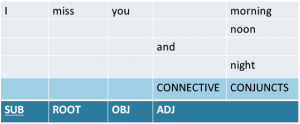< BACK TO Project overview
What is a list? Is it a linguistic object, a cognitive process, or both?
As a linguistic object, a list has been defined as a jonction of two or more elements occupying the same structural position in a dependency structure (Blanche-Benveniste et al. 1990; Gerdes & Kahane 2009). This allows for:
- Dependency tree representation (cf. Gerdes & Kahane 2009):

- Grid representation (Blanche-Benveniste et al. 1990):

- Linear representation: e.g. I miss you { morning | noon | ^and night }
From a more cognitive perspective (cf. Langacker 1987), the phenomenon of lists has been analyzed as a symmetric construal of a specific relation between two or more conceptual entities, mirrored in discourse by the juxtaposition or explicit connection of chunks that speakers process together (Blakemore 1987, 1989).
We aim to:
- bring together evidence coming from neighboring fields of research, in order to understand to what degree the cognitive process of listing is mirrored by list constructions and by their discourse use;
- provide a definition of list, which may be employed as valid tertium comparationis in the study of the intra-linguistic, inter-linguistic and diachronic variation attested for listing.
